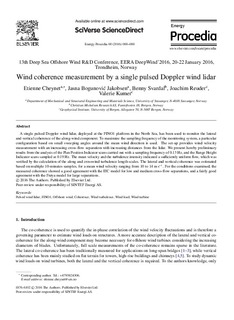| dc.contributor.author | Kumer, Valerie-Marie | |
| dc.contributor.author | Cheynet, Etienne | |
| dc.contributor.author | Jakobsen, Jasna Bogunovic | |
| dc.contributor.author | Svardal, Benny | |
| dc.contributor.author | Reuder, Joachim | |
| dc.date.accessioned | 2017-03-28T07:27:52Z | |
| dc.date.available | 2017-03-28T07:27:52Z | |
| dc.date.created | 2016-10-23T16:22:37Z | |
| dc.date.issued | 2016 | |
| dc.identifier.citation | Cheynet, E. et al. (2016) Wind coherence measurement by a single pulsed Doppler wind lidar. Energy Procedia. 2016, 94 462-477. | nb_NO |
| dc.identifier.issn | 1876-6102 | |
| dc.identifier.uri | http://hdl.handle.net/11250/2435526 | |
| dc.description.abstract | A single pulsed Doppler wind lidar, deployed at the FINO1 platform in the North Sea, has been used to monitor the lateral and vertical coherence of the along-wind component. To maximize the sampling frequency of the monitoring system, a particular configuration based on small sweeping angles around the mean wind direction is used. The set-up provides wind velocity measurement with an increasing cross-flow separation with increasing distances from the lidar. We present hereby preliminary results from the analysis of the Plan Position Indicator scans carried out with a sampling frequency of 0.13 Hz, and the Range Height Indicator scans sampled at 0.19 Hz. The mean velocity and the turbulence intensity indicated a sufficiently uniform flow, which was verified by the calculation of the along and crosswind turbulence length scales. The lateral and vertical coherence was estimated based on multiple 10-minutes samples, for a mean wind velocity ranging from 10 to 14 ms1. For the conditions examined, the measured coherence showed a good agreement with the IEC model for low and medium cross-flow separations, and a fairly good agreement with the Frøya model for large separations. | |
| dc.description.sponsorship | A single pulsed Doppler wind lidar, deployed at the FINO1 platform in the North Sea, has been used to monitor the lateral and vertical coherence of the along-wind component. To maximize the sampling frequency of the monitoring system, a particular configuration based on small sweeping angles around the mean wind direction is used. The set-up provides wind velocity measurement with an increasing cross-flow separation with increasing distances from the lidar. We present hereby preliminary results from the analysis of the Plan Position Indicator scans carried out with a sampling frequency of 0.13 Hz, and the Range Height Indicator scans sampled at 0.19 Hz. The mean velocity and the turbulence intensity indicated a sufficiently uniform flow, which was verified by the calculation of the along and crosswind turbulence length scales. The lateral and vertical coherence was estimated based on multiple 10-minutes samples, for a mean wind velocity ranging from 10 to 14 m s -1. For the conditions examined, the measured coherence showed a good agreement with the IEC model for low and medium cross-flow separations, and a fairly good agreement with the Frøya model for large separations. | nb_NO |
| dc.language.iso | eng | nb_NO |
| dc.publisher | Elsevier Ltd. | nb_NO |
| dc.subject | vindturbiner | nb_NO |
| dc.subject | vindenergi | nb_NO |
| dc.subject | offshore wind | nb_NO |
| dc.subject | pulsed wind lidar | nb_NO |
| dc.subject | coherence | nb_NO |
| dc.subject | wind turbulence | nb_NO |
| dc.subject | wind turbine | nb_NO |
| dc.subject | wind load | nb_NO |
| dc.title | Wind coherence measurement by a single pulsed Doppler wind lidar | nb_NO |
| dc.type | Journal article | nb_NO |
| dc.type | Peer reviewed | nb_NO |
| dc.rights.holder | (c) 2016 The Authors. | nb_NO |
| dc.subject.nsi | VDP::Teknologi: 500::Miljøteknologi: 610 | nb_NO |
| dc.source.pagenumber | 462-477 | nb_NO |
| dc.source.volume | 94 | nb_NO |
| dc.source.journal | Energy Procedia | nb_NO |
| dc.identifier.doi | 10.1016/j.egypro.2016.09.217 | |
| dc.identifier.cristin | 1393747 | |
| cristin.unitcode | 217,8,5,0 | |
| cristin.unitname | Institutt for konstruksjonsteknikk og materialteknologi | |
| cristin.ispublished | true | |
| cristin.fulltext | postprint | |
| cristin.qualitycode | 1 | |
